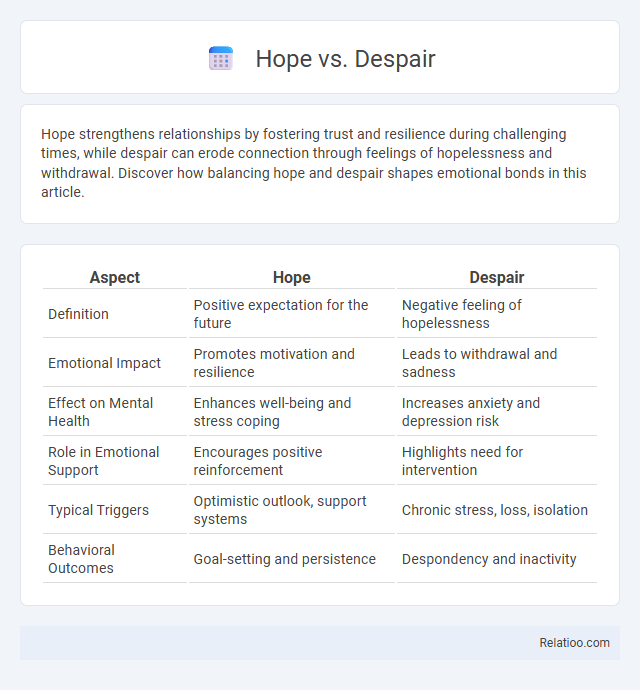Hope strengthens relationships by fostering trust and resilience during challenging times, while despair can erode connection through feelings of hopelessness and withdrawal. Discover how balancing hope and despair shapes emotional bonds in this article.
Table of Comparison
| Aspect | Hope | Despair |
|---|---|---|
| Definition | Positive expectation for the future | Negative feeling of hopelessness |
| Emotional Impact | Promotes motivation and resilience | Leads to withdrawal and sadness |
| Effect on Mental Health | Enhances well-being and stress coping | Increases anxiety and depression risk |
| Role in Emotional Support | Encourages positive reinforcement | Highlights need for intervention |
| Typical Triggers | Optimistic outlook, support systems | Chronic stress, loss, isolation |
| Behavioral Outcomes | Goal-setting and persistence | Despondency and inactivity |
Understanding Hope and Despair
Hope is a powerful emotional state that fuels optimism and resilience, driving individuals to pursue goals despite adversity. Despair, in contrast, embodies a profound sense of hopelessness and defeat, often leading to inaction and withdrawal from efforts. Understanding hope and despair enables you to recognize emotional cues, fostering mental strength and encouraging proactive coping strategies during challenging times.
The Psychology Behind Hope
Hope serves as a powerful psychological resource that fuels motivation and resilience in the face of adversity by promoting positive future expectations. Despair, on the other hand, often stems from perceived helplessness and leads to diminished mental well-being and a lack of goal-directed energy. Understanding the psychology behind hope allows you to cultivate a mindset that transforms challenges into opportunities for growth and recovery.
The Roots of Despair
The roots of despair often stem from prolonged exposure to trauma, social isolation, and a loss of meaning or purpose in life. Neurobiological changes, such as imbalances in serotonin and dopamine levels, exacerbate feelings of hopelessness and helplessness. Addressing these foundational causes through therapy, community support, and targeted interventions is essential for restoring hope and emotional resilience.
How Hope Shapes Our Actions
Hope drives your decisions by fostering resilience and a positive mindset, enabling you to overcome obstacles and pursue goals with determination. Unlike despair, which often leads to stagnation and inaction, hope motivates proactive behavior and adaptive problem-solving. By sustaining optimism, hope shapes your actions toward growth and meaningful progress.
Despair and Its Impact on Mental Health
Despair significantly affects mental health by intensifying feelings of hopelessness and helplessness, often leading to depression and anxiety disorders. Your emotional resilience can be diminished as despair disrupts cognitive functions and impairs decision-making abilities. Addressing despair through therapy and support systems is crucial to restore mental well-being and foster a renewed sense of hope.
The Interplay Between Hope and Despair
Hope and despair exist in a dynamic interplay where hope fuels resilience and forward momentum, even in the face of adversity. Your mindset shifts as despair challenges optimism, yet hope re-emerges through the belief in positive outcomes and meaningful change. This continuous tension between hope and despair shapes emotional well-being and drives personal growth.
Strategies to Nurture Hope
Cultivating hope involves setting clear, achievable goals and maintaining a positive mindset to counter despair. Techniques such as visualization, affirmations, and building supportive relationships enhance resilience and promote optimistic outcomes. Regular reflection on progress and adapting strategies reinforce a hopeful perspective, fostering emotional well-being.
Overcoming Despair: Practical Steps
Overcoming despair involves actively engaging in positive coping mechanisms such as mindfulness, seeking social support, and setting achievable goals to rebuild your mental resilience. Identifying the root causes of despair allows you to challenge negative thought patterns and replace them with empowering beliefs centered around hope. Cultivating hope through daily affirmations and focusing on small victories enhances emotional strength, enabling you to navigate difficulties with renewed purpose.
Stories of Transformation: From Despair to Hope
Stories of transformation from despair to hope reveal powerful narratives where individuals overcome profound challenges, illustrating resilience and human spirit. Examples include overcoming addiction, surviving trauma, and rebuilding lives after loss, highlighting the psychological and emotional shifts that catalyze positive change. These stories emphasize the role of support systems, self-awareness, and perseverance in transforming despair into lasting hope.
The Power of Hope in Challenging Times
Hope serves as a vital psychological resource that empowers individuals to navigate adversity, fostering resilience and motivation even during the darkest moments. Despair, in contrast, can erode mental strength and hinder problem-solving abilities, but rekindling hope transforms challenges into opportunities for growth. Your ability to harness the power of hope can significantly influence emotional well-being and drive positive outcomes in tough situations.

Infographic: Hope vs Despair
 relatioo.com
relatioo.com